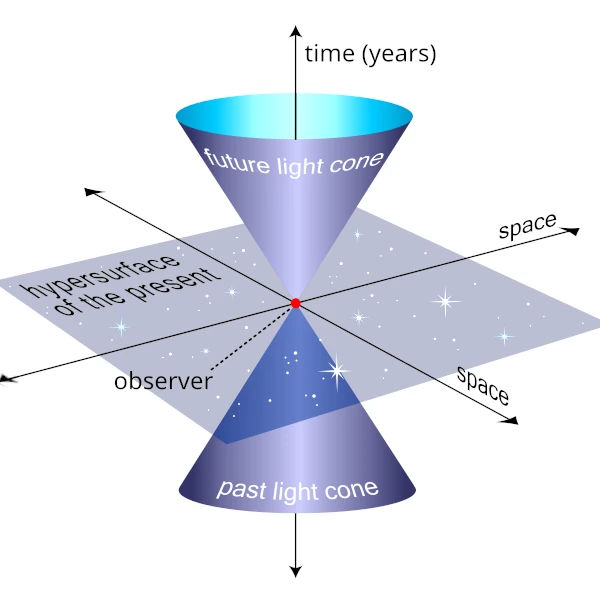
Before the 20th century, space and time were considered separate entities: space was absolute, structuring distances, while time flowed uniformly. In other words, space was a rigid stage where everything unfolded, and time, an infallible metronome that kept the beat without ever slowing down or speeding up.
This Newtonian view was overturned in 1905 by Albert Einstein's (1879-1955) theory of special relativity, which demonstrated that measurements of space and time depend on the observer's frame of reference, that is, the position and movement of the observer. Henceforth, events must be described in a unified four-dimensional framework: three of space and one of time.
Our brain has been selected to navigate a world with three spatial dimensions and linear time. However, relativity forces us to imagine four intertwined dimensions, where space and time are no longer independent, which is impossible.
We cannot "see" the fourth dimension directly, only in limited 3D analogies, and no single image is sufficient.
No analogy perfectly captures the 4 dimensions + curvature. However, we can project mathematical models.
In special relativity, the relationship between space and time is expressed by the invariance of the spacetime interval \(s^2\). \(s^2\) measures the "distance" (spatial and temporal separation) between two events A and B in spacetime. Even if different observers may disagree on the duration or distance separating them, the combination of both, given by \(s^2\), remains the same for all. This is the universal measuring rule of spacetime.
This expression is used to determine the nature of the separation between two events in spacetime. \[ \Delta s^2 = c^2\Delta t^2 - \Delta x^2 - \Delta y^2 - \Delta z^2 \] This means that an increase in the spatial component results in a decrease in the temporal component, and vice versa.
This occurs when the time difference between the two events is large enough for \(c^2\Delta t^2\) to be greater than the sum of the squares of the spatial differences \(\Delta x^2 + \Delta y^2 + \Delta z^2\).
In this case, the two events can be connected by a signal traveling at a speed less than or equal to the speed of light. This means that one event can causally influence the other.
The events are said to be "timelike separated," and there exists a reference frame in which the two events occur at the same spatial location but at different times.
This occurs when the sum of the squares of the spatial differences \(\Delta x^2 + \Delta y^2 + \Delta z^2\) is greater than \(c^2\Delta t^2\).
In this case, no signal can travel fast enough to connect the two events without exceeding the speed of light. The events cannot causally influence each other.
The events are said to be "spacelike separated," and there exists a reference frame in which the two events occur at the same time but at different spatial locations.
\(\Delta s^2 > 0\) indicates a timelike separation where causal influence is possible, while \(\Delta s^2 < 0\) indicates a spacelike separation where no causal influence is possible.
The light cone is the graphical representation of all possible paths that light can take from a given event. It is the ultimate limit of what can influence us and what we can influence.
In black holes or in the expanding universe, the interchangeability between space and time becomes extreme: at the horizon of a black hole, time "freezes" for the distant observer, while the radial coordinate becomes temporal. In the primordial universe, where the expansion of space is rapid, cosmic time flows more slowly as space "grows." It is a true compensated dynamic: spatial expansion absorbs time.
Thus, in relativistic physics, space is not independent of time: they are two faces of the same entity. A variation in one implies a response in the other, somewhat like two conjugate variables of a constant-sum system. One might say: "when space extends, time slows down."
The concept of spacetime allows us to predict measurable phenomena: the deflection of light by stars (lensing), time dilation (slower time in strong gravity), or the existence of gravitational waves, first detected in 2015 by LIGO. These ripples in spacetime confirm that it is dynamic, deformable, undulating like a cosmic membrane.
At the quantum or cosmological scale, spacetime could exhibit even more exotic structures: wormholes, quantum fluctuations, or "foam" of spacetime according to quantum gravity. These investigations are at the frontier of theoretical physics, between general relativity and quantum mechanics.
| Model | Nature of Time | Nature of Space | Gravitational Interaction |
|---|---|---|---|
| Classical Physics (Newton) | Absolute and universal | Fixed, three-dimensional | Instantaneous force at a distance |
| Special Relativity | Relative to the reference frame | Merged with time (4D) | No gravity |
| General Relativity | Curved by matter | Flexible, curved, dynamic | Geometric deformation |
Sources: Einstein Papers Project, LIGO Caltech, Scientific American – Einstein & Spacetime.